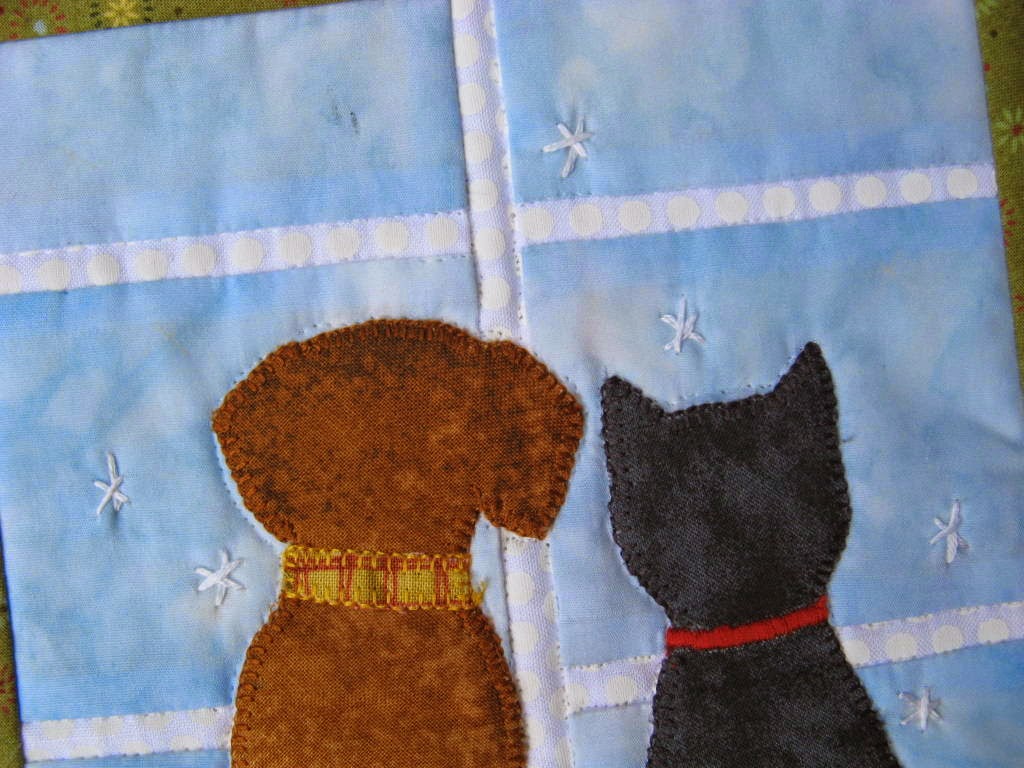It's the middle of August, hot and humid, but I've been getting prepared for the cold and snow that are sure to come. I just finished stitching up a "Snowball Fight" in the form of soft, flannel lap quilt. Seasons don't match, but as a pattern maker, I really do have to plan ahead, and winter is really not that very far off.
 |
| "Snowball Fight" |
It all started with the mittens. I really wanted to do something with mittens, but until I visited my local quilt shop I didn't know that I'd be making a snowball fight. You see, they had brought in these richly colored Woolies Flannels by Maywood.
Of course I couldn't resist touching the fabric. And that was all it took.
Hooked!
Soft, warm, oh so lovely. These were my mittens!
Luckily for me they had 10" layer cakes all ready to go. The idea for snowballs was born just like that!
And the best thing is that the fabrics and the whole idea of the quilt are great for boys as well as girls! How often does that happen?
Mittens + snowballs = ?
A snowball fight!
Giggle!
 |
| Love at first touch! |
In addition to the layer cake I purchased some light flannel for the background, a bit of a deep red yardage for border accent, and a half yard of creamy white to make snowballs that could represent white snow.
How to make snowball blocks in any size you like:
Start with a squares the finished size of the block. It's best to use a number divisible by three. Three inches, six inches, nine inches, twelve inches, etc. These make the math easiest.
Cut the squares the size of the finished block measurement plus 1/2". My blocks are 6" so I cut them at 6 1/2".
Then cut four background squares for each block. They need to be exactly one third of the size of the finished block plus 1/2".
Six divided by three equals two. Add 1/2". So I cut my background squares at 2 1/2". Sewing is quick.
Photos tell the story.
Snowballs in the center, a couple of narrow borders, a wide border filled with mittens, and hand stitched scallops stringing the mitten together.
That's it! Easy peasy!
Well, except for having to rip out some seams and redo them plus other expected minor catastrophes along the way. You know how it goes. Just normal "stuff".
I really debated about the quilting. I considered spirals, and that idea was well liked by my facebook friends and by my friend, Midge.
But I was worried. Flannel is thick and this little quilt has batting and a flannel back, too! Making smooth, large spirals on my little sewing machine would be hard enough on a quilt made of lightweight quilting cottons. I didn't even want to attempt stuffing this one into my machine and making large swirls.
I considered this and that, and then I settled for stitch-in-the-ditch and straight line quilting on the snowball panel. My walking foot came in so very handy for that!
Since the inside was so plain, I decided to quilt the dickens out of the border. And, I was off on the cathedral windows free motion stitching adventure. It's a bit tedious, but I love this pattern!
If well done, the quilting looks like intersecting circles.
Just one teensy little problem. My circles weren't really circles at all. In fact they were downright wobbly and irregular. I needed A LOT more practice!
This is a good sized border, so I practiced away. In fact, I got a ton of practice while quilting this border! It got a little bit better as I moved around the quilt. You can tell exactly which side of the border I started on, but who's going to look that closely?
 |
| The first side of my cathedral windows border |
Stitching the cathedral window free motion quilting pattern:
Mark a grid on the area to be quilted. I chose a 1 1/4" grid. Smaller is actually easier than larger.
This is how the quilting goes. A diagram shows it best.
Just follow the arrows.
Down one square, over to the right, under to the left and repeat till you reach the end of the row.
Then across to the right, scoop in on left in each square going up the grid till you get to the top.
Scoop to the right and start over again.
Draw your own grid or download one from the internet and practice with a pencil for a bit. Then try it on a piece of fabric.
Here you can see my progress. I'm making my scoops too deep, but I didn't figure that out for a very long time.
Filling in all around the mittens was a bit tricky, but I have to say, I enjoyed the work.
I stitched up a cathedral window it each of the white snowball blocks, too. Just to decorate them up a bit.
I'm really liking this little quilt and I've learned a lot from it as this was my very first actual quilt made of flannel. The soft warmth is perfect for cold winter evenings.
I had lots of leftover fabric from the layer cake so I put it to use on the back of the quilt. A section of 9" strips inserted in the back cut down on the fabric I needed to buy and added a bit of color as well.
I've been thinking of other ways to work with flannel, too.
If I someday want to make one that's lighter weight, I might consider using a single layer of fleece on the back instead of batting and flannel backing. A cotton backing with the batting would also be lighter weight. For a summer quilt, two layers of flannel with no batting in between might be nice.
Happy stitching, everyone!










































